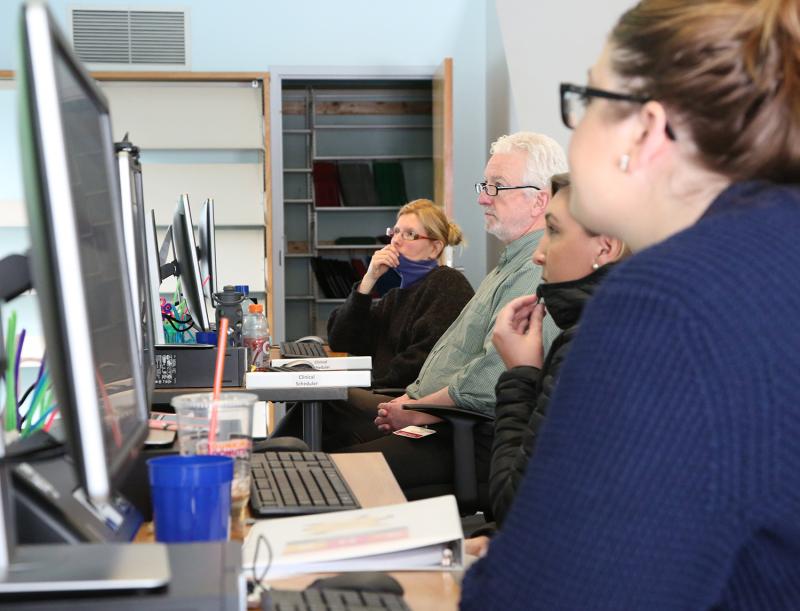Electronic health record coming to LincolnHealth
 LincolnHealth employees are currently training for the Shared Electronic Health Record (SeHR) system that is scheduled to go live later this spring. The new system will allow inpatient providers to access critical health information more quickly, and allow patients to more easily access their health information. Courtesy of LincolnHealth
LincolnHealth employees are currently training for the Shared Electronic Health Record (SeHR) system that is scheduled to go live later this spring. The new system will allow inpatient providers to access critical health information more quickly, and allow patients to more easily access their health information. Courtesy of LincolnHealth
 LincolnHealth employees are currently training for the Shared Electronic Health Record (SeHR) system that is scheduled to go live later this spring. The new system will allow inpatient providers to access critical health information more quickly, and allow patients to more easily access their health information. Courtesy of LincolnHealth
LincolnHealth employees are currently training for the Shared Electronic Health Record (SeHR) system that is scheduled to go live later this spring. The new system will allow inpatient providers to access critical health information more quickly, and allow patients to more easily access their health information. Courtesy of LincolnHealth
In the 30 years Mark Fourre, MD, has been an emergency physician, patients have gotten sicker, diagnoses more complex and medication lists longer.
When a patient arrives at the Maine Medical Center Emergency Department, they may have 15 or more medications, several different complex diagnoses and a lengthy medical record including a litany of test results and hospitalizations.
SeHR (short for Shared Electronic Health Record), MaineHealth’s electronic medical record, gives providers all of that information, including a synopsis of the most vital data on one page, a sort of short-form medical biography.
For the sickest patients, fast access to a complete medical record can make the difference between life and death, said Dr. Fourre.
For every patient, SeHR offers the promise of quicker, safer and less expensive care by helping to avoid duplication of tests and giving providers the information they need to begin treatment sooner.
In its simplest form, SeHR is a complete medical record for every patient, accessible in real time to all of that patient’s providers.
In a larger sense, however, it is a powerful new form of medical infrastructure, one that today allows patients to communicate more easily with their own providers and in the future promises many new capabilities to better manage and even prevent disease.
One day, for example, SeHR may allow providers to monitor their sickest patients remotely, so doctors can schedule an appointment when a diabetic person’s blood sugar rises too high or when a patient with congestive heart failure experiences sudden unexplained weight gain.
As part of the MaineHealth system, LincolnHealth has been building and integrating the infrastructure to make SeHR a reality for about 10 years. Lincoln Medical Partners practices are already part of SeHR. In April, LincolnHealth hospital will also join the system.
When the hospital joins SeHR, emergency physicians and hospitalists will not only be able to see a patient’s complete medical record but also update it in real time so primary care physicians can follow changes in their patients’ care plan, including medication changes.
While the process has not been an easy one, the payoff in terms of patient care is substantial.
Cindy Wade, RN, executive vice president of LincolnHealth, said that having all patient information on one record will help the small community hospital do what it does best — provide high quality care with a personal touch — even better.
Currently, hospital providers often have to piece together a patient’s medical history using several different systems.
That fragmentation can make it harder for nurses and physicians to double check a patient’s medication list and it can delay care if vital information is not available.
Now, when a patient from the Miles Campus of LincolnHealth is transferred to Maine Medical Center or another hospital, the patient’s entire medical record has to be printed out and physically transferred with them.
Having a single electronic medical record will not only help avoid errors, it will allow doctors, nurses and other providers to spend less time trying to piece together a patient’s medical history and more time on patient care.
“When everybody can communicate and see all the same information, you improve continuity of care and quality and safety,” said Wade.
Dr. Dan Friedland, a primary care physician at Lincoln Medical Partners Wiscasset, has been at the core of the effort to build and implement SeHR.
In his own practice, Dr. Friedland has seen SeHR, and specifically the MyChart component improve communications between patients and providers.
Patients are using SeHR to ask questions of providers, get prescriptions refilled and check test results. At flu season, MyChart allows Dr. Friedland to send reminders to patients about upcoming flu clinics.
Over time, as more hospitals and practices adopt electronic medical record systems and as those systems become better at communicating with each other, they may also play a role in keeping patients safe by helping to more quickly spot worrisome trends, whether that means a particularly nasty strain of the flu or a new mosquito-borne virus that had previously only been found in South America.
Event Date
Address
United States






















